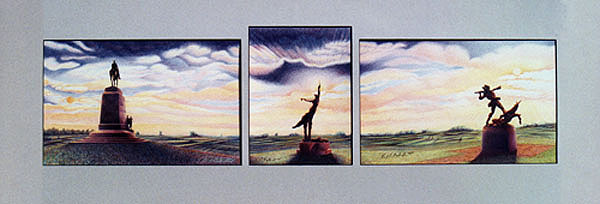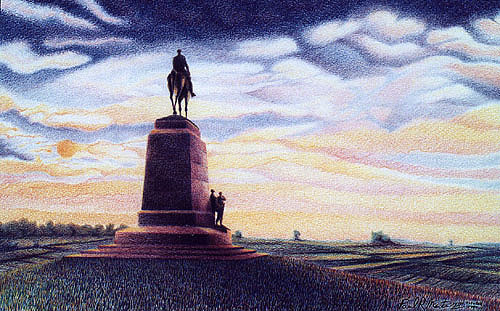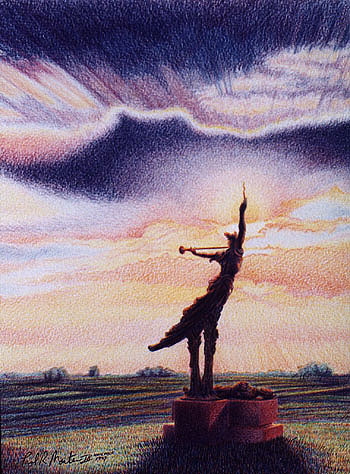 |
 |
 |
 |
 |
 |
 |
 |
 |
 |
Home |
Edition Prints |
us: Bio/Exhibits |
Fund Raiser |
New |
Us |
Schedule |
Preservation Links |
Prints, Notecards, Posters |
covers |
 |
 |
 |
 |
 |
 |
 |
 |
 |
 |
Home |
Edition Prints |
us: Bio/Exhibits |
Fund Raiser |
New |
Us |
Schedule |
Preservation Links |
Prints, Notecards, Posters |
covers |
|
|
 "Confederate Sunrise" Virginia, Louisiana and Mississippi Image Size 12" x 44" (combined width) Release Date: July 2001 Edition size 500: 50 A/P: 25 P/P Price: Regular Edition of 500: 3 piece set, $340.00 with matching #'s, Plus $10.00 Flat Shipping  Price: Regular Edition of 500: 3 piece set $550.00 with matching #'s Handsomely and Professionally Framed Plus $40.00 Shipping   Sold Individually Below: “CONFEDERATE SUNRISE” The Virginia, Louisiana and Mississippi Monuments Sunrise and sunset can often be the most glorious times of the day. At Gettysburg the vast unobstructed open spaces are especially conducive to wondrous displays of light, earth and sky. “Confederate Sunrise” was inspired by a beautiful sunrise on July 3, 1996. It evolved into the idea of a panoramic triptych during a stroll along West Confederate Avenue that brilliant morning. The image represents the progression of the sunrise as I walked from North to South along the avenue. The sun gradually ascends in the eastern sky behind the monuments, subtly altering and changing the colors and shadows of the early morning clouds. The morning light gently skips and dances across the rolling fields of Picket’s Charge and paints the earth with a colorful radiance. I have striven to capture the breathtaking beauty and the quiet sense of wonder that I experienced that tranquil and enchanting morning. Created specifically for the Cyclorama Exhibit, “Confederate Sunrise” was also conceived as a companion piece to “A Light Caress” and was intended to be the centerpiece of the show. The drawing reiterates an underlying theme of my work. It suggests that the magnificent, wondrous beauty of the Gettysburg National Military Park stands as a symbol of the United States’ strength and grandeur, reborn from the ashes of the Civil War. The United States of America emerged from the conflict of the Civil War, a stronger nation, recommitted to the ideals of freedom and liberty for all people. The actualization of this commitment was a gradual and painstaking process, and one that we still struggle with to this day. But this renewed sense of democracy also projected America into a position of world power and leadership. Today the United States of America stands as a role model of democracy throughout the world. As America accepted this new found status and challenge, it necessitated the need to create a sense of pride and nationalism that validated America’s place in the world. It was imperative for the United States to create and celebrate a rich National military heritage. That heritage was primarily defined by the Civil War, and resulted in the honoring of the military heroes of that conflict, both North and South. This time period coincided with the 25th Anniversary of the Battle of Gettysburg and saw the dedication of dozens of monuments erected on the field. Our undivided nation carried the torch of liberty across the globe in the late 1800’s and into the twentieth century. America’s manpower and industrial might helped turn the tide of World Wars I and II. The support and contribution of the new South was especially evident during World War II. Their commitment to the “cause” and the war effort is undeniable. The small town of Bedford, Virginia gave 120 of their “sons” to Company A of the 116th Infantry Regiment. In the first wave of the Normandy invasion on D-Day, this Company took 96% casualties assaulting “Bloody Omaha” Beach. The town grieved the loss of 14 of their young men killed in action that day. The 116th was awarded a Presidential Citation for their gallant action on D-Day morning. General George Patton was a native Virginian and a descendant of Confederate officers killed during Pickett’s charge at Gettysburg. In command of the U.S. Third Army, Patton’s lightning assault across France and Germany helped to bring a quick and decisive victory for the Allies in the European Theater. Mr. Andrew Jackson Higgins of New Orleans, Louisiana, designed and built thousands of “Higgins” boats. The ingeniously designed and easily manufactured landing craft enabled the boys from Bedford, and thousands of U.S. Infantrymen to make effective landings at Normandy and other invasion beaches in the latter stages of the War. President and Supreme Commander, Allied Expeditionary Force, General Dwight D. Eisenhower said from his home in Gettysburg in 1964, “He was the man who won the war for us. Lt. Waverley Wray of Company D, 505th Parachute Infantry regiment of the 82nd Airborne Division was an avid woodsman and native of Batesville, Mississippi. At dawn on June 7, 1944, the second day of the Normandy Invasion, he reported to his commanding officer, Col. Ben Vandervoort. Lt. Wray told Vandervoort of the enemy troop movements he had spotted just north of Ste-Mere-Eglise. Wray’s earlier reconnaissance and backwoods intuition led him to believe that a major German counter-attack was about to be launched against the small number of American troops in the area. Vandervoort ordered Wray to have his company attack the Germans before they could begin their attack. As Wray’s company prepared for their assault, Wray again went out to reconnoiter and assess the enemy’s position. He worked his way through the hedgerows and reached a place where he heard German voices on the other side of a hedge. Wray burst through the hedgerow and ordered eight German officers to “Hande Hoch!”. One of the officers pulled his pistol and Wray instantly shot him. Two Germans 100 meters behind Wray opened up on him with machine guns. Dropping to one knee Wray methodically shot the other seven officers as they tried to run away. He moved into a ditch, reloaded, turned and shot the two machine gunners with one shot each. Wray then returned to his company and led a successful attack that stalled the German advance before it even had a chance to get rolling. The following day Vandervoort, Wray and Sgt. John Rabig returned to the scene of Wray’s encounter. Wray insisted on burying the ten German bodies. Vandervoort and Rabig noticed that each one was killed by a single shot to the head. Sgt. Rabig commented to Vandervoort, “Colonel, aren’t you glad Waverly’s on our side?”. Lt. Wray was killed in action at Nijmiggan, during operation Market Garden on September 19, 1944. His heroics went unrecognized, known only to those who fought beside him. From 1941 through 1945, the son’s of Virginia, Louisiana and Mississippi fought alongside the son’s of Connecticut, New York and Pennsylvania. The boys from Texas, North Carolina and Tennessee joined those from Minnesota, Ohio and Michigan. The soldiers of the North and South became the soldiers of the United States of America. They courageously picked up their guns, not to conquer, but to liberate. Descendants of Rebs and Yanks, together, “they did nothing less, than save the world.” “.....The fighting at Fort Donelson was completely cast in the shade by the cool courage and bull-dog obstinacy with which either side contested every inch of ground. The English press have spoken in rather a disparaging tone of the valor of the American Nation. This action will show to the world that neither the North or the South can be excelled in courage or valor by any race upon the face of the globe. Although battling for the National Government, I could not but feel proud that the force engaged against us that displayed such desperate deeds of valor were of the same race, blood and people. Of those opposed to us, I have no doubt the majority conscientiously believed that we were infringing upon the rights of the South. Holding those views, I do not wonder at their conduct on the field. We look at it from a different stand-point; but we cannot but regret that political differences should drive the South into rebellion against the best Government that, we think, has ever existed. I hope the time is not far distant when we will again be a united people. What a front we can then present to the world! Foreign powers will then be a little more cautious in their intervention, when they know what kind of material they have to contend against. A foreign war would re-unite the popular heart of the American people.....” H. 2nd Iowa Infantry Pittsburg Landing, Tennessee, April 10, 1862 Too much time has passed and too much has happened since the Civil War, for the sectionalism that divided our nation then, to impact upon our feelings and attitudes now. It is imperative for us as Americans to celebrate the United States’ common heritage. We must take pride in the valor and sacrifice displayed by both sides upon the fields of Gettysburg. As we move into the next millennium, it is critical that we don’t forget our past or the terrible disagreement that divided us for five long years. We still need to continue to learn from it. As the thematic centerpiece of my Gettysburg Exhibit, “Confederate Sunrise” is designed to commemorate the allegorical implications of Gettysburg. The battlefield at Gettysburg allows us to pause and remember the young nation that struggled so mightily for its identity and the young men who sacrificed their lives so that it might live. It allows us to reflect and honor our nation’s historic past and our rich military heritage. Most importantly, it causes us to recognize our common ground and too look forward to the work that still needs to be done to assure the high ideals of our founding fathers. The Gettysburg Battlefield also allows us to appreciate and honor all the men who have fought together beneath the Stars and Stripes since then. Those men and the men in Blue and Gray who fought at Gettysburg, deserve no less. Paul R. Martin III June, 2000 ©2000 by Paul R. Martin III. Published by SILENT SENTINEL STUDIO, PO Box 551, Yorktown Heights, NY 10598. (914) 245-8903   "Confederate Sunrise" Virginia Image Size 11" x 17" Release Date: July 2001 Edition size 500: 50 A/P: 25 P/P Price: $140.00 each The Virginia Memorial was sculpted by Frederick William Sievers. Sievers was a young Northern artist, born in Indiana who had a studio in New York. He did grow up in Atlanta and Richmond, which pleased the monument commission. He had studied sculpture in Paris and Rome. His design was chosen over forty others that had been submitted to the commission from throughout the country. The Virginia Memorial was the first Confederate Memorial to be placed on the fields of Gettysburg. The total height of the monument is 41 feet. The monument features seven Virginians posed in various stances of combat across the front of a granite base. The sculptor intended each figure to represent a specific civilian occupation. They are from left to right; a professional, a mechanic, an artist, a boy, a businessman, a farmer and a youth. They were also meant to represent the common Private from each of the three branches of the service that participated in the battle: the infantry, cavalry and artillery. They were modeled intentionally robust to symbolize the vigor of the Confederate Army. The central figure is a mounted cavalryman who carries a Virginia State flag. General Lee, astride Traveller adorns the very top of monument. Sievers did extensive research to accurately portray General Lee and Traveller, including studying many photographs, and examining Lee’s life mask and coat. He also studied Traveller’s preserved skeleton and located a live horse of Traveller’s size to assist him in modeling the war horse. Critics have praised the likeness and realism of both Lee and Traveller. The memorial was placed at the edge of Spangler’s Woods at the spot where General Lee watched 6,000 Virginians advance against the Union position on Cemetery Ridge on the afternoon of July 3. Significantly, he stares silently across the fields towards an equestrian monument of General Meade, his adversary during the battle. Coincidental to my monograph and its reference to D-Day, the text on the monument states that it was dedicated on June 6, 1917. The actual ceremony took place two days later on June 8, 1917 in order to coincide with a reunion of Confederate soldiers in Washington DC. It was unveiled by General Lee’s granddaughter, Anne Carter Lee.   "Confederate Sunrise" Louisiana Image Size 8 1/2" x 11 1/2" Release Date: July 2001 Edition size 500: 50 A/P: 25 P/P Price: $100.00 each The Louisiana and Mississippi Monuments were both created by Donald DeLue. DeLue also created “The Spirit of American Youth”. That Memorial stands guard over the American Cemetery at Point du Hoc, above the Normandy Beaches. It honors the thousands of American soldiers who gave their lives during the invasion and the battles that raged across Southern France during the Summer and Fall of 1944. The Louisiana Monument was dedicated on June 11, 1971 and presented to the NPS by Governor John J. McKeithen. The sculpture represents a female figure apparently “floating” above the body of a fallen soldier. Several explanations claim that the female figure represents the Spirit of the Confederacy or St. Barbara, the patron saint of artillery. She holds in her right hand a flaming cannonball as her left hand holds a trumpet to her lips “blowing the long shrill clarion call over the long forgotten shallow graves of the Confederate dead. It is taps for the heroic dead at Gettysburg”. Below the figure is a fallen soldier clutching a Confederate flag to his heart. A dove of Peace is in the reeds at the base of the monument.   "Confederate Sunrise" Mississippi Image Size 11" x 44" Release Date: July 2001 Edition size 500: 50 A/P: 25 P/P Price: $140.00 each Dedicated on October 19, 1973, the Mississippi Monument honors the 14 units from the State that fought at Gettysburg. It was placed at the position held by Barksdale’s Brigade on July 2, just prior to their attack on the Union’s Peach Orchard line later that afternoon. The figures represent a soldier swinging his rifle like a club, who struggles in hand-to hand combat above the body of his comrade, a fallen color bearer. Paul R. Martin III June, 2000 ©2000 by Paul R. Martin III. Published by SILENT SENTINEL STUDIO, PO Box 551, Yorktown Heights, NY 10598. (914) 245-8903 | Silent Sentinel | Whispers At The Wall | July Morning | Ascension | Confederate Sunrise | Vision Place of Souls | Duty, Honor, Country | Hospital Woods | Ego Te Absolvo | Sons of Virginia | Eternal Glory | The Wheatfield | In Forneys Field | Long Remember | A Light Caress | moment of valor | Before The Charge | | Gettysburg Series | Great American Portrait Series | WWII Series | Revolutionary War Series | Civil War Series | West Point Series | Banners Of Glory Series | | Return Home | Limited Edition Prints | About us: Bio/Exhibits | 9-11 Fund Raiser | What's New | Contact Us | Events Schedule | Friends- Preservation Links | Mini Prints, Notecards, Posters | book covers | |
||
